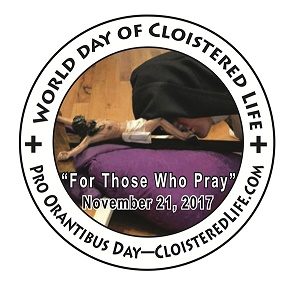We celebrate this day because the contemplative life is a gift from Almighty God to us all — all the world benefits spiritually from the prayer and sacrifice of these dedicated and faithful souls, even when we may not know it. On this day, the faithful are encouraged to reach out to the cloistered and contemplative communities in their diocese, through prayer, encouragement, and material support.
Back in 2013 the Irish bishops reminded us:
Every 21 November, the Memorial of the Presentation of the Blessed Virgin Mary, is the annual day that the Catholic Church commemorates the hidden life of cloistered and contemplative religious throughout the world. This liturgical feast of Our Lady is very dear to Christians in the East who have celebrated it since the sixth century. Tradition tells us that as a young girl Mary presented herself completely to God in the Temple at Jerusalem. She is seen as a true living temple in which God the Father placed his Son, our Saviour.
This feast is a fitting day on which to remember all those who have been consecrated to God and who spend their life in the silence and prayer of contemplative monasteries. They may well be separated from the busy world, with all its interests and pleasures, but they remain very near to us with their prayers. They pray for us but we are normally unaware of the graces we receive through their lives of quiet dedication to the Lord.
On this Pro Orantibus Day – which means ‘For those who pray’ – we remember not only the 26 communities of contemplative sisters and six communities of male contemplatives in Ireland, and the many communities of committed contemplatives around the world. While it may not be readily apparent to us in this country, contemplatives also exist where life is disrupted by warfare or where religious freedom is curtailed by open or subtle persecution. Ireland went through such trials in the 17th century. Others suffer in this way today.
Although they are hidden from society, people of faith have trust in the prayers of nuns and monks and friars. It is sufficient to visit any contemplative monastery to become aware of the constant stream of people who come with prayer intentions, trusting in the intercession of those who have completely dedicated their lives to God in continuous prayer and penance.
The busy world often passes by our contemplative monasteries, heedlessly unaware of their existence or of the spiritual influence they exert on society. Parishes, especially those who have such communities near at hand, could draw attention to their presence by placing a notice in their parish bulletins and on their online and digital platforms. Catechists could mention this way of life, to which some young girls or boys might be called, and even take a school class to visit them and spend an hour with some of the enclosed women or men whose life always fascinates young people. Although not a very common vocation in life, the Lord does call some, and will continue to do so, to this type of dedicated life on behalf of the Church. An Intercession added to the Prayer of the Faithful for vocations to the contemplative life would be opportune on 21 November or on the nearest Sunday.
The Church is well aware of the importance of the contemplative life. The Second Vatican Council (1962 – 1965) acknowledged the important role of contemplative communities in the Church. It said they were “a fount of heavenly blessings” and that they “lend lustre to God’s people with abundant fruits of holiness, sway them by their example and enlarge the Church by their hidden apostolic fruitfulness” (Perfectae Caritatis, 7).
All popes in recent times have expressed their appreciation for this way of life. In the Jubilee Year 2000, Blessed John Paul II asked Benediction Congregations to “be eloquent signs of the validity of monastic life for our contemporaries. This is the first form of consecrated life that appeared in the Church, and that down the centuries continues to remain a gift for everyone”.
Perhaps the most striking witness to the whole world on the value of a hidden life of prayer was given by Pope Emeritus Benedict XVI, who earlier this year, on account of advanced age and diminished physical strength, retired from the Petrine ministry on 11 February and chose “to devote himself even more to prayer and meditation” in a secluded monastery in the Vatican gardens. This is an important reminder to us all of the apostolic value of a life completely dedicated to God.
Contemplative communities are power houses of prayer, drawing down many graces on our troubled world. In their own silent but effective way they contribute enormously to the work of re-evangelisation of our secularised world.

No comments:
Post a Comment
Note: only a member of this blog may post a comment.